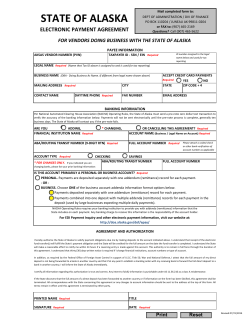
WWAMI fact sheet
Alaska WWAMI Medical Education 2015 Alaska’s Medical School WWAMI Facts WWAMI has been AK’s medical school for over 44 years. More than 414 Alaska residents have earned medical degrees through WWAMI (97% completion rate). The average return rate of AK students graduating from WWAMI is 47%; this number increases to nearly 84% return-on-investment, when including all non-AK WWAMI graduates practicing in the state. Over 170 AK Physicians have clinical faculty appointments at UW. It takes a minimum of 7 years from entry to practice to become a physician (4 years in medical school, 3 years in residency). Alaska has a shortage of physicians: primary care, psychiatry, emergency medicine AK WWAMI graduates choose primary care residencies (61%) More than 71% of state funds committed each year to the WWAMI program are spent in Alaska AK WWAMI students who do not return to AK to practice must ‘payback’ the state’s subsidy AK’s aging population and rural/frontier nature combine to produce a large medically underserved population. Program Summary In 1971, Alaska entered into a cooperative program with the University of Washington School of Medicine (UWSoM) and the states of Montana, Idaho and Wyoming subsequently joined, resulting in “WWAMI”, the acronym for the partner states. WWAMI’s goal is to make medical education accessible to students in northwestern states that do not have independent medical schools, and to help meet physician workforce needs for each of the states. Alaska WWAMI Program Goals: 1. Access to public medical education for Alaska residents (UWSoM- top 10 US medical school) 2. Alaska physician workforce: encourage graduates to choose careers in primary care medicine and locate their practices in underserved or rural areas in Alaska 3. Support and encourage talented students, especially minority students, to enter the field of medicine How Does the Program Work? The program operates through a decentralized education process. In Alaska, 20 new medical students enter the program each year and complete their 1st year of studies on the UAA campus. Until 2015, students joined WWAMI participants from other states in Seattle for the 2nd year of classroom studies, this is now changing. New Curriculum and new opportunity for Alaska A new curriculum commences in fall semester, 2015, where Alaska WWAMI students will spend the equivalent of the 1st and 2nd year of medical school at UAA, for the 18 month Foundations Phase. Alaska WWAMI students will no longer relocate to Seattle for classes. Clinical training (years 3 and 4) can be completed in Alaska, and across the WWAMI region. Both Anchorage and Juneau offer the full complement of third-year clinical training, and single-specialty clinical rotations for both the third and fourth years are available across Alaska (243 student rotations in 2014-open to all WWAMI students). This provision of clinical training in Alaska engages over 170 Alaska physicians in helping educate the next generation and helps recruit WWAMI students to Alaska communities. State Support The state of Alaska provides a subsidy for each student enrolled in the program. For FY14 the state provided $2.9 M to support 59 students in years 2-4 of the WWAMI program at an average subsidy per student of $49,000 annually, while students pay on average an additional $30,000 in tuition per year. Also, the state of Alaska supports the 1st year program at UAA. Collectively, over 71% of state funds committed each year to the WWAMI program is spent in Alaska, supporting classroom teaching at UAA and clinical teaching of WWAMI students in 43 clerkships located throughout the state. Alaska Physician Workforce Alaska has a shortage of physicians, especially primary care doctors. Alaska WWAMI continues to address this need, with an 84% return on investment (translating to approximately 17 WWAMI graduates returning to Alaska to practice for every 20 students Alaska trains). The majority of Alaska WWAMI students choose to practice in primary care (61%). The partnership between the University of Washington School of Medicine and Alaska continues to be a productive and cost-effective approach for meeting the needs of the physician workforce in Alaska. WWAMI School of Medical Education University of Washington School of Medicine University of Alaska Anchorage Director, Professor, Asst. Dean, Jane Shelby PhD (907) 786-4772 Suzanne Allen MD, Vice Dean, Academic Affairs and Regional Affairs (208) 364-4552 Tom Nighswander MD, Asst Dean, Alaska Clinical Coordinator (907) 786-474
© Copyright 2025









